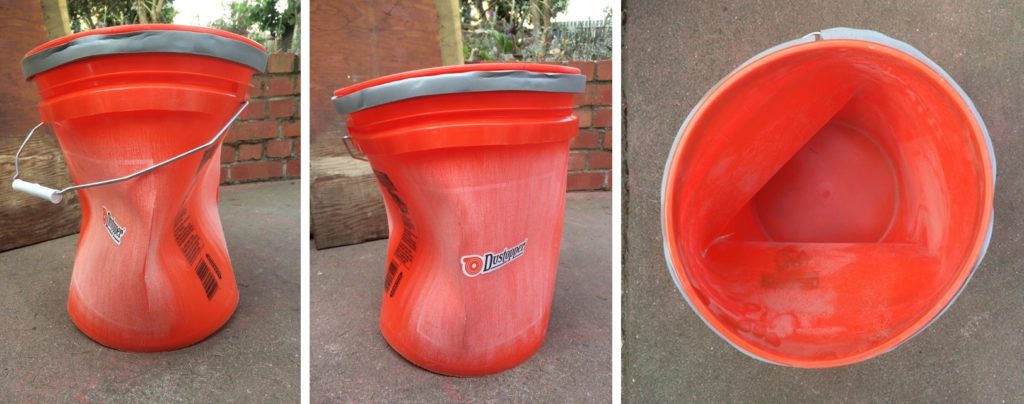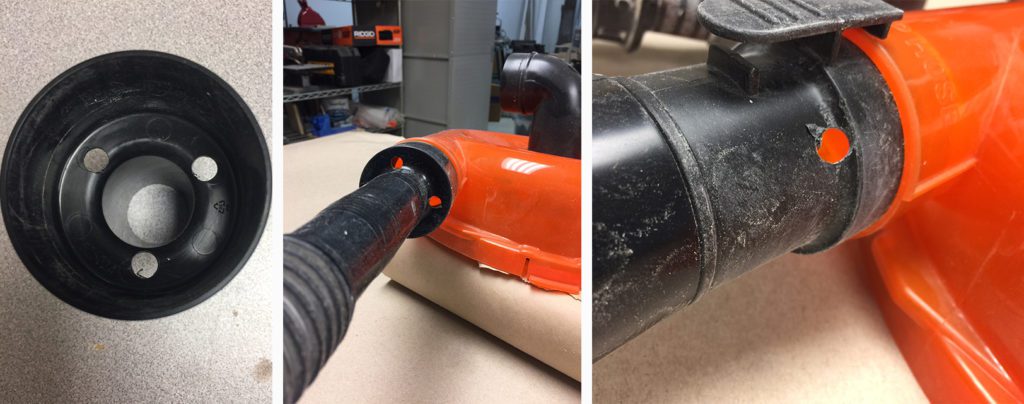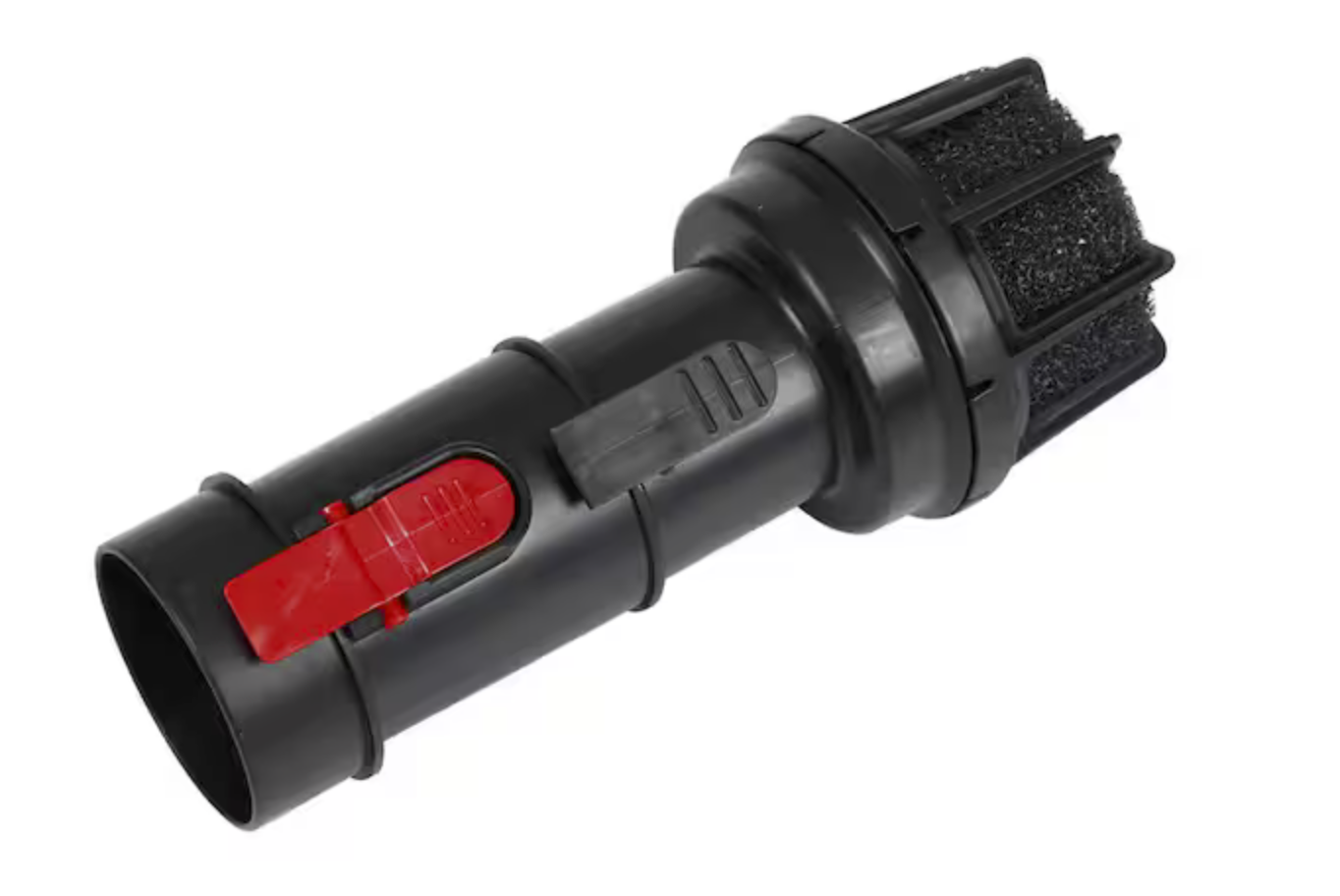Help
Frequently Asked Questions
INSTRUCTIONS – SCROLL DOWN AND CLICK ON A TOPIC TO LEARN MORE
Q: Why is the bucket collapsing? How do you fix it?

A: A collapsing bucket is due to there being too much flow restriction, a weak bucket or pail, or an uncommonly powerful vacuum. Often it is two or more of these conditions. Flow restriction can occur with a pickup hose that is too long, a hose with smaller than normal diameter, a tool that doesn’t allow sufficient airflow (i.e. orbital sander), a blockage in the hose, etc. When the flow of air into the Dustopper is restricted or the bucket is too weak, the bucket may be sucked in.
There are a few things one can do to improve the flow of air into the bucket. They are: Avoid using a pickup hose that is longer than 12-15 feet; If you are using a reducer, drill three 5/16 or 3/8” holes around the face of a reducer or on the hose cuff (depending on which is closest to the input port of the Dustopper); Make sure there are no kinks or very sharp bends in the hose. Keep in mind that reducing flow restriction results in faster air flow which results in better separation. Using a different bucket is often a good remedy when flow is otherwise good, but you are using an exceptionally powerful vacuum. i.e. >90” of water lift. Food safe buckets are generally a good choice. Buckets that have their thickness marked on the bottom are good if they are 90 mil (0.090”) thick or thicker.
What should you check?
- A reducer in the pickup hose that is also connected to a hose of much smaller diameter
- The addition of a very long pick-up hose
- The connection of an orbital sander, a crevice tool, or some other device having a design that severely restricts air flow
- A complicated setup that includes multiple fittings
- Something large lodged in the hose (this is pretty rare)
- Most often the above will have a greater likelihood of happening when a very powerful vacuum is used.
- European vacs often have as much as 90+ inches of water lift and can easily collapse buckets
- US vacs generally are below 50” of lift, with some having more than 6 HP (Peak) producing slightly more. Buckets that are a bit on the flimsy are at risk. This includes the Homer Bucket
The fixes:
- A simple configuration with no restriction points generally produces the best results
- If you notice your bucket collapsing when you use an orbital sander, we suggest drilling three 5/16” or 3/8″ holes in the hose cuff or reducer that is closest to the Dustopper

- This reduces vacuum in the collection bucket (stops implosions), and the induction of take-up air allows for faster flow within the separator which results in better separation.
- There will still be plenty of suction to bring dust from orbital to the separator.
- Purchase a bucket that is 90 mil (0.090″) thick or thicker.
Q: I am getting a large amount of debris in my vacuum and filter. What is causing this?
A: Whenever there is a complaint about filter clogging, the issues we focus on generally relate to anything in the Dustopper’s configuration that slows air flow. Cyclonic separators work best when airflow is high.
For example: A CNC owner recently reached out to us writing that a majority of dust from his CNC machine was going into his vacuum and clogging the filter. He also explained that he had a dust collection boot attached to the router on his CNC. We asked for a photo, and noticed that the “grass skirt” on his dust boot was positioned to float directly on the surface of the material he was cutting. We then asked if he would position his boot in a range of 1/4-3/8” above the working surface when the cutter was at its desired cutting depth, and then report back to us. The change was made, and the problem was solved. After lifting the grass skirt, suction in the cavity created by the grass skirt was still sufficient enough to force dust to flow into the connected hose. The gap allowed more air to enter the system, which then increased air flow through the hose and allowed higher centrifugal forces to act upon the particulate moving through the separator. Better than 99% separation was achieved.
Here’s a list of things for you to be on the lookout for:
- Reducers, elbows, crevice tools, and the like…all slow down air flow
- Very long hoses, or hoses of smaller diameter
- Tools not designed to accommodate maximum air flow
- Grinders with shrouds
- Orbital and palm sanders
- Drywall sanders
- Hoses with kinks and other forms of damage that pinch off air flow
- Putting a new Dustopper on a vacuum that already has an old (clogged) filter.
- Vacuums with less than 100cfm (when unobstructed) air flow. For best results, higher air flow in the 150 CFM range is better.
- Complex networks of PVC with multiple “blast gates”.
Hopefully these are things you are considering. In nearly every situation where this is an issue, we have been successful in prescribing a workable solution. We would be happy to offer an opinion of your present configuration if you can provide a photo, or perhaps some additional description of configuration by email us at service@dustopper.com.
Q: Major bucket colapse: When I used my Fein vacuum without any power tools I didn’t have any problems whatsoever. However, yesterday I tried to use use the Dustopper with a DeWalt palm sander and was sad to see my bucket end up looking like the picture below. What is a good way to prevent this?

A: First, some simple “physics.” Vacuums suck! It’s that simple. Some more than others! If one looks at the performance specifications of the European vacuums, they will notice they can lift a column of water as high at 90” or more. In US terms, this specification is called “Inches of water lift”. In other words, if you had a clear hose with one end immersed into a bucket of water, and a typical European vacuum connected to the other end at a height of 100 inches, the suction power of the vacuum is enough pull the water almost all the way up! This distance is measured and recorded as the vacuum’s suction specification. Your Fein vacuum has a water lift specification of between 90 and 99”. This is NOT a measure of how much air flows. More on that in a minute. Bosch, Fein, and Festool vacuums all have suction specifications that exceed 90” of water lift. US-made vacuums range from about 40-60” of water lift.
From Fein’s website: Vacuums having strong suction along and good flow, or cubic feet per minute (CFM), can easily lift very dense debris like screws and nails. Both flow (CFM) and suction (inches of water lift), are necessary for good overall performance in a shop setting. Manufactures of all vacuums know they must make the dust compartments of their vacuums strong enough to withstand maximum pressure should the end of the pickup hose be closed off or plugged, otherwise the dust compartment would collapse. Since a bucket with a dust separator was not a part of their original design consideration, vacuum design engineers had no concern about what could happen when a standard 5-gallon bucket was included in the air pathway. Vacuums with high suction are great at pulling debris away from cutting tools like routers, drills, CNCs, etc. Vacuums with high flow are better for planing, cutting dados, or any other operations where large volumes of debris are made very quickly. There’s no such thing as a “best” vacuum; it largely depends on how you use one.
Here’s what is happening with your bucket:
When you attach a palm sander to the end of the hose, the pressure differential between the outside and inside of the hose is very high. If there is a bucket and a separator in that air pathway, the surface most impacted by the pressure differential will be the inside of the bucket. That means the walls of the bucket are quickly drawn inward, causing the bucket to collapse. Buckets, incidentally, are designed to work with pressure from the inside-out, not from the outside-in.
Below are some photos of modifications I’ve made to hose adapters that will usually eliminate the problem. The holes in the reducer allow air to continue flowing thereby keeping the internal pressure from causing the bucket to implode.

Q: I have an older RIDGID wet/dry vac. The ID of the vac intake fitting is 2-5/8″ diameter. How do I make the Dustopper fit?
A: The easiest fix is to purchase the RIDGID 2-1/2 in. Diffuser Accessory (CLICK HERE FOR THE DIFFUSER ACCESSORY) and use the red tab adapter that comes with it to connect your vacuum to your Dustopper. Be sure to save the diffuser for future use. For the pickup hose, you may need to purchase a new hose to fit the input port of the Dustopper. CLICK HERE FOR THE HOSE

Q: I have a 14 gal 5.0 HP shop vac with 1.5″ hoses. If I were to buy adapters to fit the 2.5″ on the Dustopper will I have any issues?
With adapters, as long as everything is connected tight, it will work just fine. At 5.0 HP you will still be getting good separation as we generally recommend using a vacuum of 5.0 HP or more. That being said, the stronger the vacuum the better the separation. Being on that line, you may see a little more of the finest dust get through, but if everything is running and connecting well, you will see good results. Try it out! If you run into any issues we are happy to do some troubleshooting with you.
Q: Can you vacuum water through the Dustopper?
A: Dustopper can be a best friend when mitigating flood damage in a basement, or for collecting water in general. Here’s the setup:
- Remove the pleated filter
- There’s no dust to filter from the air and we don’t want tiny droplets of spray to moisten the filter.
- Now, use your Dustopper for picking up water, same as you would for dust.
- When the bucket under the Dustopper is nearly full, simply detach the Dustopper and carry the bucket away for easy disposal.
- When all water has been collected, empty what little made it into the vacuum’s collection container.
- There may be a cup or two there as well.
- Easier to carry around and empty a bucket of water than do the same with a wet/dry vacuum!
- When your done, wipe down the inside of the vacuum’s container, and then restore the original Dustopper setup.
Q: Will a Dustopper work well with a conventional central shop vacuum with 4″ Ductwork?
A: This is a very good question, and the answer may surprise you until you think the dynamics of air flow. Large, central vacuums are capable of moving hundreds of CFM, or many times the flow volume moved by a typical wet/dry vacuum. But….their ability to move a large volume of air requires movement of the air through a fairly large diameter duct, typically 4 inches. Stepping down to a 2-1/2” diameter hose does not concentrate the power to a smaller outlet….UNLESS there is sufficient static suction held in reserve. If you were to measure the static suction of your Shop Fox blower, you would find that it has very little static suction; a little less than 6” of water lift, versus 45-90” of water lift on a typical shop vac. (See the specs for your vacuum below my comments)
Static pressure is always measured on a closed system, and is the maximum amount of suction a vacuum motor can create. In reality, the maximum amount of air, measured in CFM, that can be drawn through a 4” duct at 5.67” of lift is about 800 CFM. Since most wet/dry vacs have 8-15X the static suction, they are able to move much more air through a 2-1/2” hose than will your much larger Shop Fox vacuum.
Cyclonic separators also restrict air flow, so using on a vacuum with low static pressure adds another wrinkle to the problem. In order to get maximum separation from a cyclone, the source of vacuum should be able to overcome the added restriction of airflow caused by the cyclone, AND have enough concentrated power to move a large volume of air through a relatively small hose.
Bottom line: You would be disappointed with ANY cyclone type separator designed for use with 2-1/2 hose that would be interfaced to your Shop Fox vacuum. Dustopper is looking at a larger size of separator for use with central vac systems, and our goal is to make as product announcement later this fall.
Q: Will the Dustopper work well with a Bosch dust extractor? The Bosch dust extractor generates 150 CFM and 97 inches of static water lift.
A: This is a GREAT and important question.
The European vacs operate at nearly 2X the water lift of US vacs. If your vacuum is used with a table saw, a router, a bandsaw, or even a drum sander, Dustopper will do a great job since most of those connections involve a larger diameter hose. That said, there will be a problem with powerful European vacs IF something in your setup severely restricts air flow.
Dustopper loves the suction and does a great job with Fein, Festool, and Bosch, but some buckets may collapse when something in the air pathway causes a restriction. From our experience, a collapsing bucket issue almost always happens with high static pressure vacs when they’re used with orbital sander or some other device that is connected to a small diameter hose, or has a small orifice within its design that chokes the system. This could include concrete grinders, drywall sanders, and the like.
Bosch and Festool have excellent hoses with vents at the tool end to infuse air, thereby allowing the flow of air through the hose to remain high. This mitigates the bucket collapsing problem, but the problem then becomes the hose, which generally is less than half the cross-section of a typical 2-1/2” (nominal) vacuum hose. So, even with the vent wide open, a collapsing bucket is still possible but less infrequent.
We have experimented with placing a 2-1/2” hose coupler between the Bosch (or other sander’s) connection and the input port of the Dustopper. This setup allows air velocity within the Dustopper to remain high, which also supports better separation. And, since there is far more suction at the tool than is required to move very fine particles, the setup also does a good job of keeping the workspace clean.
We have an example of nearly every cyclonic separator made, and it is our observation that all of them work better with air being infused at the intake port of the separator. Since the Dustopper’s design is focused on a low profile, it relies on both cyclonic separation and centrifugal forces to remove particulate from the air, making it a bit more sensitive to air velocity than a traditional cyclone. When Dustopper is choked off, its fines separation may be impacted. With the addition of an air infusing coupler, it works on par with the tall cyclones and retains the convenience of its low-profile design.